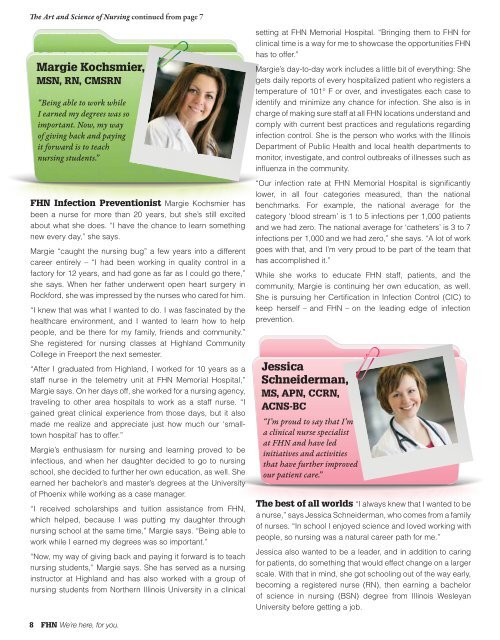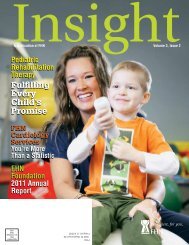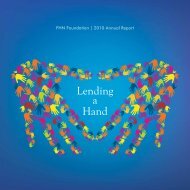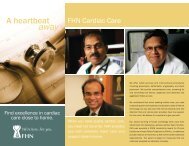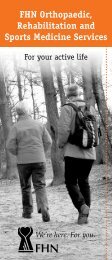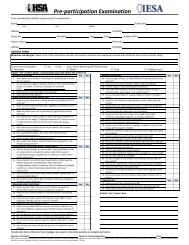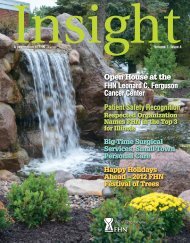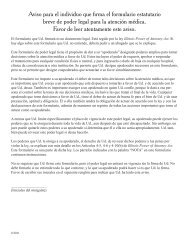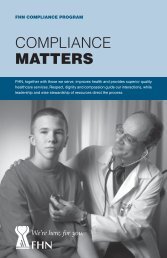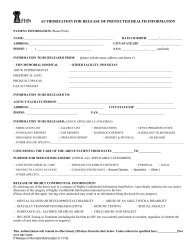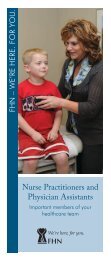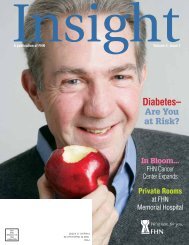The Art and Science of Nursing at FHN Be the Match and Save a Life
The Art and Science of Nursing at FHN Be the Match and Save a Life
The Art and Science of Nursing at FHN Be the Match and Save a Life
You also want an ePaper? Increase the reach of your titles
YUMPU automatically turns print PDFs into web optimized ePapers that Google loves.
<strong>The</strong> <strong>Art</strong> <strong>and</strong> <strong>Science</strong> <strong>of</strong> <strong>Nursing</strong> continued from page 7<br />
Margie Kochsmier,<br />
MSN, RN, CMSRN<br />
“<strong>Be</strong>ing able to work while<br />
I earned my degrees was so<br />
important. Now, my way<br />
<strong>of</strong> giving back <strong>and</strong> paying<br />
it forward is to teach<br />
nursing students.”<br />
<strong>FHN</strong> Infection Preventionist Margie Kochsmier has<br />
been a nurse for more than 20 years, but she’s still excited<br />
about wh<strong>at</strong> she does. “I have <strong>the</strong> chance to learn something<br />
new every day,” she says.<br />
Margie “caught <strong>the</strong> nursing bug” a few years into a different<br />
career entirely – “I had been working in quality control in a<br />
factory for 12 years, <strong>and</strong> had gone as far as I could go <strong>the</strong>re,”<br />
she says. When her f<strong>at</strong>her underwent open heart surgery in<br />
rockford, she was impressed by <strong>the</strong> nurses who cared for him.<br />
“I knew th<strong>at</strong> was wh<strong>at</strong> I wanted to do. I was fascin<strong>at</strong>ed by <strong>the</strong><br />
healthcare environment, <strong>and</strong> I wanted to learn how to help<br />
people, <strong>and</strong> be <strong>the</strong>re for my family, friends <strong>and</strong> community.”<br />
She registered for nursing classes <strong>at</strong> Highl<strong>and</strong> Community<br />
College in Freeport <strong>the</strong> next semester.<br />
“after I gradu<strong>at</strong>ed from Highl<strong>and</strong>, I worked for 10 years as a<br />
staff nurse in <strong>the</strong> telemetry unit <strong>at</strong> <strong>FHN</strong> Memorial Hospital,”<br />
Margie says. On her days <strong>of</strong>f, she worked for a nursing agency,<br />
traveling to o<strong>the</strong>r area hospitals to work as a staff nurse. “I<br />
gained gre<strong>at</strong> clinical experience from those days, but it also<br />
made me realize <strong>and</strong> appreci<strong>at</strong>e just how much our ‘smalltown<br />
hospital’ has to <strong>of</strong>fer.”<br />
Margie’s enthusiasm for nursing <strong>and</strong> learning proved to be<br />
infectious, <strong>and</strong> when her daughter decided to go to nursing<br />
school, she decided to fur<strong>the</strong>r her own educ<strong>at</strong>ion, as well. She<br />
earned her bachelor’s <strong>and</strong> master’s degrees <strong>at</strong> <strong>the</strong> University<br />
<strong>of</strong> Phoenix while working as a case manager.<br />
“I received scholarships <strong>and</strong> tuition assistance from <strong>FHN</strong>,<br />
which helped, because I was putting my daughter through<br />
nursing school <strong>at</strong> <strong>the</strong> same time,” Margie says. “<strong>Be</strong>ing able to<br />
work while I earned my degrees was so important.”<br />
“Now, my way <strong>of</strong> giving back <strong>and</strong> paying it forward is to teach<br />
nursing students,” Margie says. She has served as a nursing<br />
instructor <strong>at</strong> Highl<strong>and</strong> <strong>and</strong> has also worked with a group <strong>of</strong><br />
nursing students from Nor<strong>the</strong>rn Illinois University in a clinical<br />
8 <strong>FHN</strong> We’re here, for you.<br />
setting <strong>at</strong> <strong>FHN</strong> Memorial Hospital. “Bringing <strong>the</strong>m to <strong>FHN</strong> for<br />
clinical time is a way for me to showcase <strong>the</strong> opportunities <strong>FHN</strong><br />
has to <strong>of</strong>fer.”<br />
Margie’s day-to-day work includes a little bit <strong>of</strong> everything: She<br />
gets daily reports <strong>of</strong> every hospitalized p<strong>at</strong>ient who registers a<br />
temper<strong>at</strong>ure <strong>of</strong> 101° F or over, <strong>and</strong> investig<strong>at</strong>es each case to<br />
identify <strong>and</strong> minimize any chance for infection. She also is in<br />
charge <strong>of</strong> making sure staff <strong>at</strong> all <strong>FHN</strong> loc<strong>at</strong>ions underst<strong>and</strong> <strong>and</strong><br />
comply with current best practices <strong>and</strong> regul<strong>at</strong>ions regarding<br />
infection control. She is <strong>the</strong> person who works with <strong>the</strong> Illinois<br />
Department <strong>of</strong> Public Health <strong>and</strong> local health departments to<br />
monitor, investig<strong>at</strong>e, <strong>and</strong> control outbreaks <strong>of</strong> illnesses such as<br />
influenza in <strong>the</strong> community.<br />
“Our infection r<strong>at</strong>e <strong>at</strong> <strong>FHN</strong> Memorial Hospital is significantly<br />
lower, in all four c<strong>at</strong>egories measured, than <strong>the</strong> n<strong>at</strong>ional<br />
benchmarks. For example, <strong>the</strong> n<strong>at</strong>ional average for <strong>the</strong><br />
c<strong>at</strong>egory ‘blood stream’ is 1 to 5 infections per 1,000 p<strong>at</strong>ients<br />
<strong>and</strong> we had zero. <strong>The</strong> n<strong>at</strong>ional average for ‘c<strong>at</strong>heters’ is 3 to 7<br />
infections per 1,000 <strong>and</strong> we had zero,” she says. “a lot <strong>of</strong> work<br />
goes with th<strong>at</strong>, <strong>and</strong> I’m very proud to be part <strong>of</strong> <strong>the</strong> team th<strong>at</strong><br />
has accomplished it.”<br />
While she works to educ<strong>at</strong>e <strong>FHN</strong> staff, p<strong>at</strong>ients, <strong>and</strong> <strong>the</strong><br />
community, Margie is continuing her own educ<strong>at</strong>ion, as well.<br />
She is pursuing her Certific<strong>at</strong>ion in Infection Control (CIC) to<br />
keep herself – <strong>and</strong> <strong>FHN</strong> – on <strong>the</strong> leading edge <strong>of</strong> infection<br />
prevention.<br />
Jessica<br />
Schneiderman,<br />
MS, APN, CCRN,<br />
ACNS-BC<br />
“I’m proud to say th<strong>at</strong> I’m<br />
a clinical nurse specialist<br />
<strong>at</strong> <strong>FHN</strong> <strong>and</strong> have led<br />
initi<strong>at</strong>ives <strong>and</strong> activities<br />
th<strong>at</strong> have fur<strong>the</strong>r improved<br />
our p<strong>at</strong>ient care.”<br />
<strong>The</strong> best <strong>of</strong> all worlds “I always knew th<strong>at</strong> I wanted to be<br />
a nurse,” says Jessica Schneiderman, who comes from a family<br />
<strong>of</strong> nurses. “In school I enjoyed science <strong>and</strong> loved working with<br />
people, so nursing was a n<strong>at</strong>ural career p<strong>at</strong>h for me.”<br />
Jessica also wanted to be a leader, <strong>and</strong> in addition to caring<br />
for p<strong>at</strong>ients, do something th<strong>at</strong> would effect change on a larger<br />
scale. With th<strong>at</strong> in mind, she got schooling out <strong>of</strong> <strong>the</strong> way early,<br />
becoming a registered nurse (rN), <strong>the</strong>n earning a bachelor<br />
<strong>of</strong> science in nursing (BSN) degree from Illinois Wesleyan<br />
University before getting a job.


